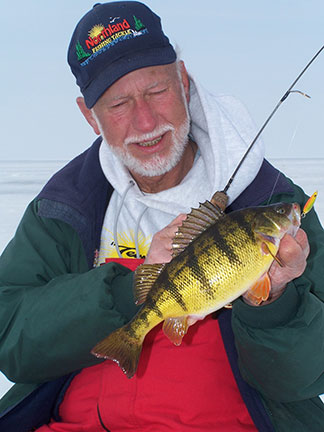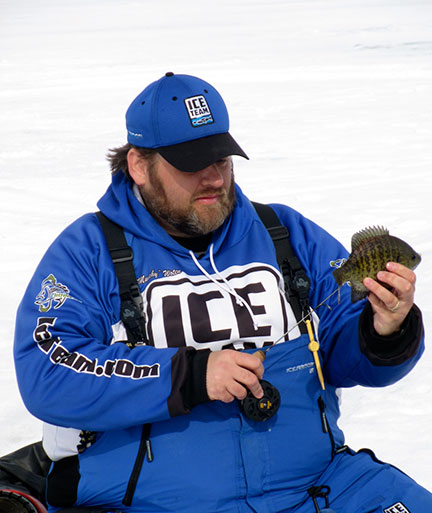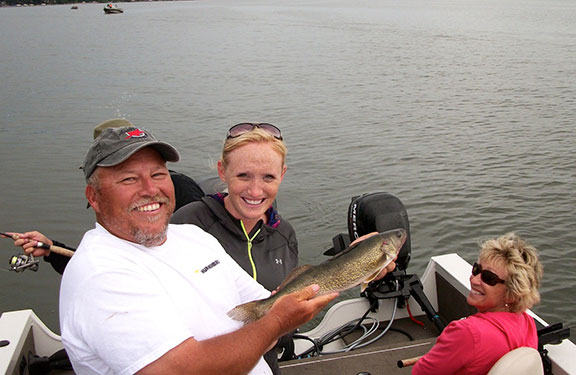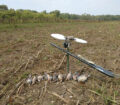By Bob Jensen
Fishing the Midwest Fishing Team

(photo by Bob Jensen): Consider lure size and action, along with color, and you’ll catch more fish whenever you go fishing.
Whether you’re fishing in open water or through the ice, the color of your lure can affect how many fish you catch. That is especially obvious when an angler is fishing through the ice and is watching a depth-finder. You see everything that goes on directly below that hole.
If a fish comes in and looks at your bait but doesn’t eat it, you know about it. If that happens too often, and three or four times is too often, something needs to be changed. One of the things that should be considered for change is color.
Thoughts on color
There are times when fish are very color conscious. Following are some ideas on color that apply to open water and ice-fishing.
The general rule-of-thumb that many successful anglers use when selecting a lure is to go with a bright bait, something with orange or chartreuse in it, in stained or dirty water. However, some choose to start with black or purple.
In clear water, natural or subtle colors are often preferred. Some like baits that resemble the primary forage fish in the body of water being fished, but some anglers prefer a bait that looks nothing like the dominant baitfish. The theory there is, if the predator fish are seeing and eating the same thing day after day after day, something that looks completely different will be more appealing.
Kind of like the person who eats hamburgers day after day after day. After a while, hamburgers lose their appeal and a hotdog looks more appealing. Give them something different and they’re more likely to eat it. I don’t know what fish are thinking, but I do know that sometimes in clear water they like natural looking baits and sometimes they like baits that look like nothing that swims in that lake or river or pond.
Color can be especially important in ice-fishing. Fish can really check a bait out when you’re ice-fishing. The bait is only going up and down, and usually pretty slowly.
In open water, if you’re casting or trolling, the bait is moving, and often pretty fast. The fish in open water need to respond quickly. Under the ice, they can take their time, and if that bait isn’t exactly what they want, they don’t eat it. Lure action and size certainly make a difference, but so does color.
We all have our favorite colors. For walleyes, I really like baits that have some orange or chartreuse in them.
When largemouth or smallmouth are the quarry, crawdad or watermelon colors are go-to, and I also like white for smallmouths.
I like something with pink for crappies, and black for bluegills.
And then again, I’ve seen plenty of times when something completely different worked better than those colors, and that’s what makes fishing both fun and challenging. You just never know. It often works well to start with the color you caught’em on last time. If they’re still eating that color, good deal. If they’re not, you need to try something else.
Some folks believe that the only reason baits are offered in different colors is so the lure-makers can sell more lures. The truth is, if that color doesn’t catch fish somewhere at some time, it won’t be around very long.
In addition to color, there are other factors that also come into play in our fishing success. Let’s talk about some of those factors.
Thoughts on size
Size is a really important consideration in open water or under the ice, but I think it’s even more important under the ice, especially when panfish are the target. A few years ago I was ice-fishing with some friends on a lake in Wisconsin that received a lot of fishing pressure.
We were after bluegills. I was using baits that were the size I usually used for bluegills: 1/32nd ounce or close to that. My friends were using baits that were half that size and even smaller. My friends were catching fish regularly: I wasn’t catching them at all. A switch to the smaller size enabled me to start catching.
In recent years, tungsten baits have become a big deal for ice-fishing. Tungsten is a heavy material, so it’s possible to have a bait that is small in size, but is still heavy enough to fish effectively. Northland’s Mooska Tungsten Jig has been very popular because it’s been very effective for finicky panfish.
Thoughts on lure action
Action is another factor that we need to consider when we’re on the ice or in a boat, but again, many anglers will agree that the action we impart or don’t impart on our bait is often more critical when ice-fishing.
Sometimes, in fact much of the time, it works well to really shake your bait for a few seconds to get the attention of any fish that might be in the area. If that fish is hungry, it might move right in and eat your bait.
However, usually it works best to put a lot of action on the bait to get the fish’s attention, then let the bait sit as still as possible so the fish can eat it. There are times when fish are like people this way: People and fish need to know food is around, but we usually don’t like it moving when we eat it.
We’re usually tipping our jigs or spoons with bait. There are times when fish like live bait, but more and more we’re finding that plastic baits work just as well and sometimes even better than live. There are times when the wiggling of a live waxworm or spike or whatever is unappealing to a fish.
There have been plenty of times in recent years that a jig or spoon tipped with plastic has been better. Impulse plastics look real and smell real, but they don’t wiggle by themselves, and they’ll catch fish when live bait won’t. And, if you want the plastic to wiggle, you just shake your rod tip a little bit.
We can put as much or as little thought into our fishing as we want. We can think about every little factor and how it might affect our success, or we don’t need to, and that’s what makes fishing so appealing to so many people. But, if you want to catch more fish, it really pays to consider the various details that go into our lure presentation. The more attention we pay to lure color, size, and action, the more fish we’ll catch.
To see the newest episodes of Fishing the Midwest television go to fishingthemidwest.com Visit us at Facebook.com/fishingthemidwest.


















